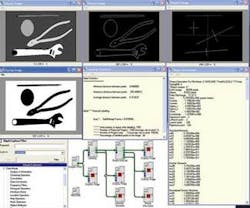Glyph-based program moves into machine vision
Andrew Wilson, Editor, [email protected]
Since its purchase of the KhorosPro image-processing software package from Khoral in May 2004, AccuSoft (Northborough, MA, USA; www.accusoft.com) has been adding more functionality to its renamed VisiQuest software. According to Chris Martin, product manager, the company plans a Version 5.0 release of the software later this year that will add more machine-vision functions to the package and support for a number of FireWire and Camera Link cameras and off-the-shelf frame grabbers.
“Already,” says Martin, “VisiQuest supports the IIDC/DCAM interface and allows FireWire cameras such as the XCD Series from Sony Electronics (Park Ridge, NJ, USA; www.sony.com/videocameras) to be used with the glyph-based software. By September 2006, the company will add functions to the package that directly target developers of machine-vision systems. These will include statistical image measurement tools and geometric pattern-matching functions.
As a glyph-based image-processing package, VisiQuest resembles other icon-based machine-vision packages such as LabView from National Instruments (Austin, TX, USA; www.ni.com), the Video and Image Processing Blockset from The MathWorks (Natick, MA, USA; www.mathworks.com), and WiT from DALSA Coreco (Burnaby, BC, Canada; www.logicalvision.com). Like those packages, VisiQuest allows developers to use an icon-based development system with which to build image processing and machine-vision applications. “Using glyphs to develop or prototype a program,” says Martin, “simplifies the developer’s task and speeds time to market of machine-vision applications.”
To develop an application, operator icons, called glyphs, are dragged onto a workspace and connected (see figure). “In a less-sophisticated application,” says Martin, “it may be necessary to simply find the orientation of a number of parts within an image. In such cases, just a few operators can perform the task. In the example shown in the figure, images are transferred from disk into the VisiQuest workspace. Once transferred, the labeling glyph is used to label each individual object within the image.
“To do this,” says Martin, “a minimum distance classify operator is set within the labeling glyph to measure the Euclidean distance between pixels. If this distance is zero, the result will assign to each object an individual class that can be pseudocolored.” Using the display image glyph throughout the workspace allows the developer to visualize the effects of each operator.
After the objects within the image are labeled, a shape analysis function can compute the size of each object, where it is located, and its orientation. “Rather than use geometric pattern-matching to find the orientation of each of the objects,” says Martin, “it is far simpler to compute different orders of moments that provide the area of the object, the center of mass, and the axes of orientation of the objects within the image. In this way, the position and orientation of different objects within the image can be displayed.”
In Version 5.0 of the software, glyphs will be added that allow the operator to control camera functions such as shutter speed, external trigger and frame rate. Once created, workspaces can then be shared with other workgroups, or compiled into an ActiveX control or C program. The software has also been extended by a number of universities that have created their own operator libraries with VisiQuest’s integrated development environment. In addition, the software allows MATLAB functions from the MathWorks to be imported into VisiQuest. Using AccuSoft’s Craftsman Wizard, MATLAB m-files can be imported into VisiQuest, converted to C-code, wrapped with a header, compiled, and regenerated as a glyph.

